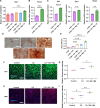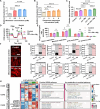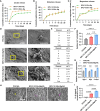Metabotissugenic citrate biomaterials orchestrate bone regeneration via citrate-mediated signaling pathways
- PMID: 40700481
- PMCID: PMC12285708
- DOI: 10.1126/sciadv.ady2862
Metabotissugenic citrate biomaterials orchestrate bone regeneration via citrate-mediated signaling pathways
Abstract
Bone regeneration requires coordinated anabolic and catabolic signaling, yet the interplay between mammalian target of rapamycin complex 1 (mTORC1) and adenosine monophosphate-activated protein kinase (AMPK) pathways remains unclear. This study reveals that citrate, glutamine, and magnesium synergistically activate both pathways via calcium/calmodulin-dependent protein kinase kinase 2 (CaMKK2)- and protein kinase B (Akt)-dependent signaling, bypassing the traditional adenosine monophosphate (AMP)/adenosine triphosphate (ATP) sensing mechanism. This dual activation supports sustained energy metabolism during osteogenesis and challenges the canonical antagonism between mTORC1 and AMPK. We developed CitraBoneQMg, a citrate-based biomaterial incorporating these components via one-pot synthesis. CitraBoneQMg provides sustained release, photoluminescent and photoacoustic imaging capabilities, and tunable mechanical properties. In vitro, it promotes osteogenesis by enhancing alkaline phosphatase (ALP) activity, osteogenic gene expression, and calcium deposition. In vivo, it accelerates bone regeneration in a rat calvarial defect model while promoting anti-inflammatory and neuroregenerative responses. We define this integrated effect as "metabotissugenesis," offering a metabolically optimized approach to orthopedic biomaterial design.
Figures









Similar articles
-
Kaempferol combats the osteogenic differentiation damage of periodontal ligament stem cells in periodontitis via regulating EphrinB2-mediated PI3K/Akt and P38 pathways.Phytomedicine. 2025 Jun;141:156733. doi: 10.1016/j.phymed.2025.156733. Epub 2025 Apr 6. Phytomedicine. 2025. PMID: 40220409
-
Astragaloside IV Promotes Osteogenic Differentiation of Periodontal Ligament Stem Cells via Activating PI3K/AKT/eNOS/NO Signaling Pathway: In vitro and in vivo Study.Drug Des Devel Ther. 2025 Jul 16;19:6073-6088. doi: 10.2147/DDDT.S514682. eCollection 2025. Drug Des Devel Ther. 2025. PMID: 40687900 Free PMC article.
-
Citric Acid: A Nexus Between Cellular Mechanisms and Biomaterial Innovations.Adv Mater. 2024 Aug;36(32):e2402871. doi: 10.1002/adma.202402871. Epub 2024 Jun 11. Adv Mater. 2024. PMID: 38801111 Free PMC article. Review.
-
Enhanced osteo-angiogenic coupling by a bioactive cell-free fat extract (CEFFE) delivered through electrospun fibers.J Mater Chem B. 2025 Jan 15;13(3):1100-1117. doi: 10.1039/d4tb01394h. J Mater Chem B. 2025. PMID: 39659270
-
Management of urinary stones by experts in stone disease (ESD 2025).Arch Ital Urol Androl. 2025 Jun 30;97(2):14085. doi: 10.4081/aiua.2025.14085. Epub 2025 Jun 30. Arch Ital Urol Androl. 2025. PMID: 40583613 Review.
References
-
- Qiao W., Wong K. H. M., Shen J., Wang W., Wu J., Li J., Lin Z., Chen Z., Matinlinna J. P., Zheng Y., Wu S., Liu X., Lai K. P., Chen Z., Lam Y. W., Cheung K. M. C., Yeung K. W. K., TRPM7 kinase-mediated immunomodulation in macrophage plays a central role in magnesium ion-induced bone regeneration. Nat. Commun. 12, 2885 (2021). - PMC - PubMed
MeSH terms
Substances
LinkOut - more resources
Full Text Sources

